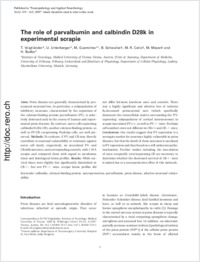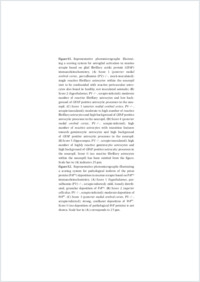The role of parvalbumin and calbindin D28k in experimental scrapie
- Voigtländer, T. Institute of Neurology, Medical University of Vienna, Vienna, Austria
- Unterberger, U. Institute of Neurology, Medical University of Vienna, Vienna, Austria
- Guentchev, M. Institute of Neurology, Medical University of Vienna, Vienna, Austria - Department of Neurosurgery, University Hospital St. Ivan Rilski, Sofia, Bulgaria
- Schwaller, Beat Unit of Anatomy, Department of Medicine, University of Fribourg, Switzerland
- Celio, Marco R. Unit of Anatomy, Department of Medicine, University of Fribourg, Switzerland
- Meyer, M. Institute of Physiology, Department of Cellular Physiology, Ludwig Maximilians University, Munich, Germany
- Budka, H. Institute of Neurology, Medical University of Vienna, Vienna, Austria
-
15.11.2007
Published in:
- Neuropathology and Applied Neurobiology. - 2008, vol. 34, no. 4, p. 435 - 445
calbindin
calcium binding protein
neuroprotection
parvalbumin
prion disease
selective neuronal vulnerability
English
Aims: Prion diseases are generally characterized by pronounced neuronal loss. In particular, a subpopulation of inhibitory neurones, characterized by the expression of the calcium-binding protein parvalbumin (PV), is selectively destroyed early in the course of human and experimental prion diseases. By contrast, nerve cells expressing calbindin D28k (CB), another calcium-binding protein, as well as PV/CB coexpressing Purkinje cells, are well preserved. Methods: To evaluate, if PV and CB may directly contribute to neuronal vulnerability or resistance against nerve cell death, respectively, we inoculated PV- and CB-deficient mice, and corresponding controls, with 139A scrapie and compared them with regard to incubation times and histological lesion profiles. Results: While survival times were slightly but significantly diminished in CB–/–, but not PV–/– mice, scrapie lesion profiles did not differ between knockout mice and controls. There was a highly significant and selective loss of isolectin B₄-decorated perineuronal nets (which specifically demarcate the extracellular matrix surrounding the 'PV-expressing' subpopulation of cortical interneurones) in scrapie inoculated PV+/+, as well as PV–/– mice. Purkinje cell numbers were not different in CB+/+ and CB–/– mice. Conclusions: Our results suggest that PV expression is a surrogate marker for neurones highly vulnerable in prion diseases, but that the death of these neurones is unrelated to PV expression and thus based on a still unknown pathomechanism. Further studies including the inoculation of mice ectopically (over)expressing CB are necessary to determine whether the shortened survival of CB–/– mice is indeed due to a neuroprotective effect of this molecule.
- Faculty
- Faculté des sciences et de médecine
- Department
- Département de Médecine
- Language
-
- English
- Classification
- Biological sciences
- License
- License undefined
- Identifiers
-
- RERO DOC 10578
- DOI 10.1111/j.1365-2990.2007.00902.x
- Persistent URL
- https://folia.unifr.ch/unifr/documents/300747
Other files
Statistics
Document views: 120
File downloads:
- schwaller_rpc.pdf: 196
- schwaller_rpc_sm.pdf: 104

